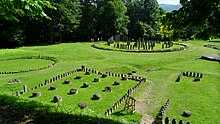
Back Dacia AN داقية Arabic داتشيا ARZ داکیا AZB Дакія Byelorussian Дакия Bulgarian Dakia Breton Dàcia Catalan Dácie Czech Dacia Welsh
Dacian Kingdom | |||||||||||||||
|---|---|---|---|---|---|---|---|---|---|---|---|---|---|---|---|
| c. 82 BC–106 AD | |||||||||||||||
 Dacia’s expansions and largest extent under Burebista c. 45 BC | |||||||||||||||
| Capital | Sarmizegetusa | ||||||||||||||
| Common languages | Dacian | ||||||||||||||
| Religion | Thracian polytheism, Zamolxism | ||||||||||||||
| Demonym(s) | Dacian | ||||||||||||||
| Government | Monarchy | ||||||||||||||
| King | |||||||||||||||
• 82–44 BC | Burebista (first) | ||||||||||||||
• 87–106 AD | Decebal (last) | ||||||||||||||
| Historical era | Classical antiquity | ||||||||||||||
• Established | c. 82 BC | ||||||||||||||
| 84–88 AD | |||||||||||||||
| 101–106 AD | |||||||||||||||
• Disestablished | 106 AD | ||||||||||||||
| |||||||||||||||
| This article is part of a series on |
 |
| Dacia |
| Geography |
|---|
| Culture |
| History |
| Roman Dacia |
| Legacy |
Dacia (/ˈdeɪʃə/, DAY-shə; Latin: [ˈd̪aː.ki.a]) was the land inhabited by the Dacians, its core in Transylvania, stretching to the Danube in the south, the Black Sea in the east, and the Tisza in the west. The Carpathian Mountains were located in the middle of Dacia. It thus roughly corresponds to present-day Romania, as well as parts of Moldova, Bulgaria, Serbia, Hungary, Slovakia, and Ukraine.[1]

A Dacian kingdom that united the Dacians and the Getae was formed under the rule of Burebista in 82 BC and lasted until the Roman conquest in AD 106. As a result of the wars with the Roman Empire, after the conquest of Dacia, the population was dispersed, and the capital city, Sarmizegetusa Regia, was destroyed by the Romans. However, the Romans built a settlement bearing the same name, Ulpia Traiana Sarmizegetuza 40 km away, to serve as the capital of the new Roman province of Dacia. A group of "Free Dacians" may have remained outside the Roman Empire in the territory of modern-day Northern Romania until the start of the Migration Period.[1]
- ^ a b "Dacia | Europe, Map, Culture, & History | Britannica". www.britannica.com. 8 August 2024. Retrieved 6 September 2024.